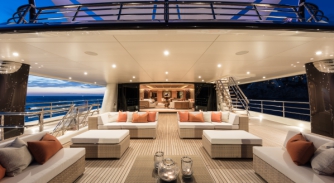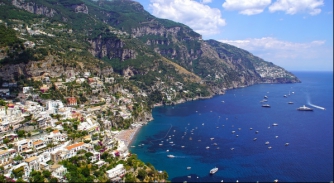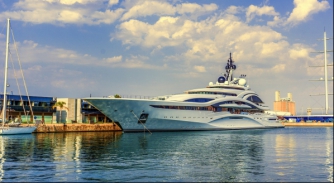The teak problem
We explore the history of teak to kickstart a series of articles on alternative materials and solutions…
Teak has been used as a material of choice for boatbuilding for more than 2,000 years, thanks to its high strength and resistance to rot, fungi and mildew, as well as its relatively low shrinkage ratio. However, with environmental and ethical issues aplenty and stockpiles of long, high-quality teak dwindling, the market has long since accepted that new solutions are needed to meet the exacting standards of superyacht buyers and owners. In the first of a series of articles that explore the teak problem and its alternatives, we explore the context and the history of the issue.
Teak, quite simply, is the best-known natural material for superyacht decking and, as a result, its qualities and characteristics have made it an indelible part of the superyachting aesthetic. This aesthetic is so engrained in yachting that the businesses producing alternative materials for superyacht decking try and make their products look as much like teak as possible, even to the detriment of the products’ performance at times.
“The problems with teak started over 20 years ago,” starts Dan Paver, sourcing and sustainability coordinator at Teakdecking Systems. “The conception that the issues started with the EUTR in 2013 isn’t accurate. However, whether you consider the environmental perspective or the political history and current issues, there is a simple mathematical truism that highlights how unsustainable our use of teak has been. We have been cutting down one-hundred-year-old logs to build a product that has a 25-year lifespan.”
When one thinks of superyachts and teak it is nigh on impossible to separate its use from the environmental and political difficulties in Myanmar. While Teak is not exclusive to Myanmar, with it also being found in Thailand, Laos and India, deforestation, limited resources and quality issues in other countries made it the de facto exporter for teak.
Under British rule from 1860 to 1930 the timber industry in Myanmar ramped up, but with rudimentary technology and unforgiving terrain, only a limited amount of damage was done in the space of 70 years. The British timber industry in Myanmar ground to a halt in the 1930s due to civil unrest and then, latterly, Word War II.
“In 1948, Myanmar gained independence and established a parliamentary democracy. Foresters continued using the British management system and rates of teak extraction were the lowest they have ever been since 1900,” explains Justine Hausheer in Deciding the Fate of Myanmar’s Forests.
“Then in the early 1960s, the military seized power in a coup d’état and implemented a nominally socialist government. In the decades that followed, a growing population and isolationist policies put pressure on the country’s resources. As timber extraction climbed steadily, Myanmar declined from one of the region’s richest countries to its poorest.”
In 1988 a second military coup saw the State Law and Order Restoration Council (SLORC) seize power, the teak forests had been managed by the socialist government of the time which, by and large, had a relatively good handle on the exportation of teak and the health of the forests; following the coup, the management of the forests altered drastically.
Once the SLORC were in control, the nation’s dire financial position became abundantly clear and, as a result, the military junta turned to the short-term profits available from Myanmar’s forests. Large-scale forestry became a political necessity for the SLORC, with the government even granting contracts to foreign entities to carry out logging along Myanmar’s borders. Indeed, alongside the numerous legitimate logging contracts that were awarded at the time, illegal logging in Myanmar grew exponentially. Under military rule, harvesting levels were determined by profit and ease of access, with little care for the long-term impact or established harvesting cycles.
In recent years it had seemed that the democratically elected government of Myanmar was starting to get a grasp on the issues of over logging its teak forests with various systems having been put in place to try and curb the impact, slow the deforestation and begin restoring the damage. However, On 1 February the armed forces launched a military coup when elected members of the country’s ruling party, the National League for Democracy, were deposed by the Tatmadaw, Myanmar’s military, which then vested power in a stratocracy (governed by military forces). In Myanmar’s previous coups in the 80s and 90s, one of the most important earners of hard currency for the various regimes proved to be timber, predominantly teak – and this coup proved to be no different. However, a series of sanctions have now rendered the exportation of Myanmar timber to the EU and the US illegal, although various reports have suggested that illegal timber is still making its way into both Europe and the US.
Moral and legal issues aside, there is another underlying issue with teak today. There is simply no longer the size and quality of teak logs to compare with what has come before. “When I started working here 20 years ago we were using saw grade one and two logs, with the levels above being veneer grade logs. Today we are getting saw grade four at very best,” continues Paver.
As a result of the environmental, political and quality issues surrounding teak the superyacht industry has been engaged in developing and utilising alternatives to teak, including, but not limited to, synthetic deck systems, laminated teak, resin-infused woods and alternative timbers. In this series of articles, we will explore the front-running alternatives to try and better understand which solutions will work in given scenarios. Interestingly, however, teak itself is having a resurgence as a solution with decking companies looking to alternative, sustainable sources of teak and becoming more creative with their deck designs to account for the reduced size of the timber.
The reality is that every one of these alternatives has a place in the market. The future will see a greater mixture of decking systems tailored to the individual tastes of each owner. Indeed, perhaps we may even witness the emergence of the first superyachts to stray away from the accepted teak aesthetic? In the articles that follow we will analyse the alternatives and consider their application. The industry is at a moral and environmental tipping point and the time to act on teak is now, if you would like to share your thoughts please feel free to contact rory@thesuperyachtgroup.com.
Profile links
NEW: Sign up for SuperyachtNewsweek!
Get the latest weekly news, in-depth reports, intelligence, and strategic insights, delivered directly from The Superyacht Group's editors and market analysts.
Stay at the forefront of the superyacht industry with SuperyachtNewsweek
Click here to become part of The Superyacht Group community, and join us in our mission to make this industry accessible to all, and prosperous for the long-term. We are offering access to the superyacht industry’s most comprehensive and longstanding archive of business-critical information, as well as a comprehensive, real-time superyacht fleet database, for just £10 per month, because we are One Industry with One Mission. Sign up here.
Related news

Raising the bar of refit…by grand design
The steps Winch Design has taken to play a major role in the refit sector
Fleet

A token gesture
How the tokenisation of physical assets on the blockchain is changing the superyacht transaction landscape
Owner

A bite-sized guide to the ‘perfect’ charter yacht
What are the essential elements of a charter yacht that appeal to clients?
Owner
.jpg)
Boat Shows: Too many? Too few? Or just right?
Has the pandemic caused lasting change or will the market revert to type where boat shows are concerned?
Business

IGY wins Málaga concession
IGY and its partners, Marina Málaga SAN and Ocean Capital Partners, have secured a 50-year concession
Business

Related news
Raising the bar of refit…by grand design
3 years ago
A token gesture
3 years ago
Boat Shows: Too many? Too few? Or just right?
3 years ago
IGY wins Málaga concession
3 years ago
Super, mega, giga, tera?
3 years ago
NEW: Sign up for
SuperyachtNewsweek!
Get the latest weekly news, in-depth reports, intelligence, and strategic insights, delivered directly from The Superyacht Group's editors and market analysts.
Stay at the forefront of the superyacht industry with SuperyachtNewsweek



